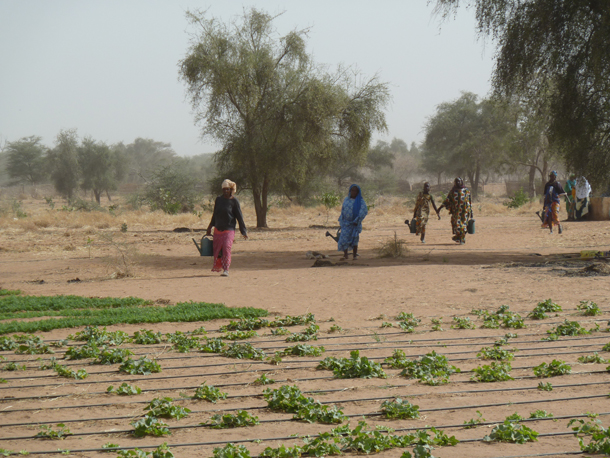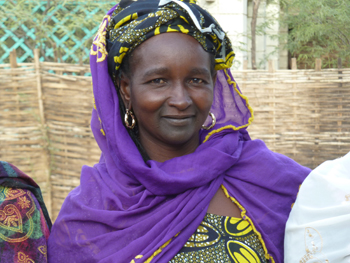Notes from Senegal. To Grow a Forest, First Start With Carrots
Published: February 6, 2018
By Bobby Bascomb

Peuhl women watering their gardens. (Photo: Bobby Bascomb)
For Senegal's Great Green Wall to be a success the government first had to get support from communities living in the region. Bobby Bascomb's second blog from Senegal explains how they did it.
Widou is a village in the north of Senegal, near the border with Mauretania. It’s built around one of the deep wells French colonists constructed at regular intervals. Water is life in this region, where the dry season lasts for 8 to 10 months. The sandy soil supports little vegetation - some dry grass and a few stringy acacia trees with large flat crowns. And as the desert spreads, even these are dying.
But the Great Green Wall can bring hope to people in hamlets like Widou. The project started here in 2008, and now, waist high bushes sprout between the flat-topped trees. The Senegalese government hopes this will one day become a forest, but their first task was to persuade the people who live here to support the project.

(Photo: Bobby Bascomb)
This was not easy, because the Peuhl, the dominant ethnic group of the Senegalese Sahel, were nomadic pastoralists. They are tall, and elegant; the women wear long silky dresses and headscarves, and often have blue tattoos on their lower lip and chin. The men wear long straight robes of emerald green and sapphire blue. Traditionally they migrated with their herds of goats and cows to shifting water sources, but now they make a daily trek to the well instead.
To convince this traditionally nomadic people to plant the wall of trees to turn back the desert, the government first persuaded them to plant carrots. Now the communities, especially the women, are planting gardens. Instead of traveling more than 30 miles to market for fresh vegetables, they harvest their own much closer to their homes. Of course, coaxing vegetables like cabbages, tomatoes, onions, even watermelons, out of the dry sand, is no easy task. But there’s an endless supply of manure fertilizer and water from the well, and they seem to be making it work.
Bobby Bascomb's reporting trip to Senegal's Great Green Wall was made possible by a grant from the Pulitzer Center for Crisis Reporting.
Back to Africa's Great Green Wall of Trees
Living on Earth wants to hear from you!
Living on Earth
62 Calef Highway, Suite 212
Lee, NH 03861
Telephone: 617-287-4121
E-mail: comments@loe.org
Newsletter [Click here]
Donate to Living on Earth!
Living on Earth is an independent media program and relies entirely on contributions from listeners and institutions supporting public service. Please donate now to preserve an independent environmental voice.
NewsletterLiving on Earth offers a weekly delivery of the show's rundown to your mailbox. Sign up for our newsletter today!
 Sailors For The Sea: Be the change you want to sea.
Sailors For The Sea: Be the change you want to sea.
 The Grantham Foundation for the Protection of the Environment: Committed to protecting and improving the health of the global environment.
The Grantham Foundation for the Protection of the Environment: Committed to protecting and improving the health of the global environment.
 Contribute to Living on Earth and receive, as our gift to you, an archival print of one of Mark Seth Lender's extraordinary wildlife photographs. Follow the link to see Mark's current collection of photographs.
Contribute to Living on Earth and receive, as our gift to you, an archival print of one of Mark Seth Lender's extraordinary wildlife photographs. Follow the link to see Mark's current collection of photographs.
 Buy a signed copy of Mark Seth Lender's book Smeagull the Seagull & support Living on Earth
Buy a signed copy of Mark Seth Lender's book Smeagull the Seagull & support Living on Earth

